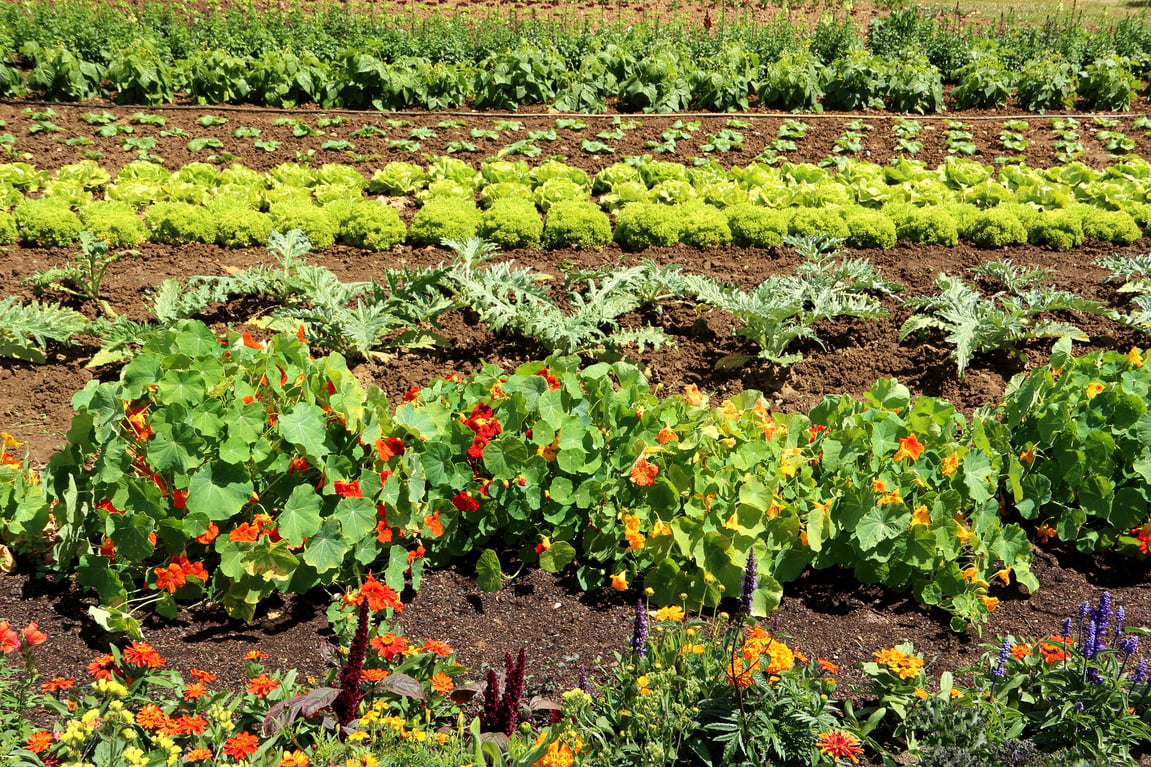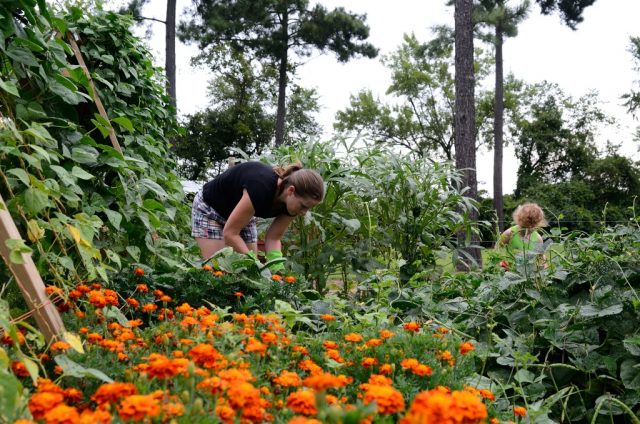Imagine stepping into your garden and seeing lush plants thriving without a hint of chemical intervention. Companion planting offers you a natural solution for keeping pesky bugs at bay.
It’s not just about growing plants; it’s about creating partnerships in your garden. You can harness the power of nature to protect your crops and boost their growth. This method allows you to experience the satisfaction of nurturing plants in harmony.
Curious about how you can implement these strategies for organic pest control in your garden? Dive into the world of companion planting and discover how simple changes can lead to a flourishing, pest-free oasis. Keep reading to unlock secrets that can transform your gardening experience.
Benefits Of Companion Planting
Growing plants together can keep pests away naturally. Certain plants help protect each other from bugs. This reduces the need for chemical pesticides. It’s a simple way to keep your garden healthy. Plus, it can improve plant growth and yield.
Companion planting is more than just a gardening technique; it’s a strategic approach to creating a thriving garden ecosystem. By carefully selecting plants that complement each other, you can naturally manage pests, reduce disease, and boost plant health. The benefits of companion planting extend beyond pest control, offering a sustainable way to enhance your garden’s productivity and vitality. ###Improved Pest Control
Companion planting helps keep pests at bay without the need for chemical pesticides. Certain plants emit scents that repel unwanted insects. For example, marigolds can deter nematodes, while basil can ward off aphids. This natural defense system means fewer pest-related issues for you to handle. ###Enhanced Soil Health
Some plant combinations can improve soil quality. Legumes like peas and beans add nitrogen to the soil, benefiting neighboring plants. This nutrient boost reduces the need for synthetic fertilizers and supports robust plant growth. Healthier soil leads to healthier plants. ###Increased Biodiversity
A diverse garden attracts beneficial insects. By planting a mix of flowers and vegetables, you create habitats for pollinators and predators that keep pest populations in check. This biodiversity strengthens the garden’s natural resilience. Have you noticed ladybugs in your garden lately? ###Optimized Space Utilization
Companion planting can maximize your garden’s space. Tall plants provide shade for sun-sensitive crops, while sprawling plants cover the ground to prevent weeds. This efficient use of space allows you to grow more in less area. Imagine harvesting twice as much from the same plot. ###Improved Crop Yield
Strategic plant pairings can lead to a bountiful harvest. When plants support each other, they flourish, producing more fruit and vegetables. Tomatoes and basil, when grown together, not only taste great but also thrive, increasing your overall yield. Have you ever tried this flavorful duo? ###Reduced Need For Interventions
With companion planting, you spend less time managing problems. The right plant combinations naturally suppress diseases and pests. This means fewer interventions and less stress for you. Isn’t it rewarding to see your garden thrive with minimal effort? Companion planting offers practical solutions for organic pest control while fostering a healthier garden ecosystem. By embracing these benefits, you can enjoy a thriving, sustainable garden that rewards both you and the environment. Ready to transform your garden into a natural haven?
Best Plant Combinations
Companion planting offers a natural way to control pests in gardens. Choosing the right plant combinations can enhance growth and deter unwanted insects. Mixing plants strategically creates a balanced ecosystem. This method not only protects crops but also boosts yield and flavor. Discovering which plants thrive together is key. Below are some of the best pairings for effective pest control.
Tomatoes And Basil
Tomatoes and basil make a great team. Basil repels flies and mosquitoes. Its aroma confuses pests, protecting tomatoes. Growing them together enhances tomato flavor. This pairing is a favorite among gardeners.
Cucumbers And Nasturtiums
Nasturtiums are beneficial for cucumbers. They deter aphids and beetles. Their bright flowers attract pollinators. This improves cucumber production. Nasturtiums also add beauty to the garden.
Carrots And Onions
Carrots and onions work well together. Onions repel carrot flies. Their scent masks carrot odors, confusing pests. This combination protects both crops. It promotes healthy growth and yields.
Marigolds And Melons
Marigolds are ideal companions for melons. They fight nematodes in soil. Their vibrant flowers attract beneficial insects. This pairing boosts melon health and flavor. Marigolds are easy to grow and maintain.
Beans And Corn
Beans and corn complement each other. Beans fix nitrogen, enriching soil. Corn provides support for climbing beans. This combination improves soil fertility. It enhances growth and production.
Implementing Companion Planting
Implementing companion planting can naturally deter pests in your garden. This method uses nature’s own strategies to enhance plant growth and protection. By choosing the right plant combinations, you can create a thriving, balanced ecosystem. This practice not only reduces pests but also improves soil health and biodiversity.
Understanding Plant Pairings
Certain plants complement each other well. Tomatoes and basil are a classic example. Basil helps repel insects that harm tomatoes. Similarly, marigolds can deter nematodes from attacking vegetable roots. Understanding these pairings is crucial for effective companion planting.
Arranging Your Garden Layout
Strategic garden layout enhances companion planting benefits. Place beneficial plants close to vulnerable ones. For instance, plant carrots near onions to keep pests at bay. This arrangement creates a natural barrier against unwanted insects.
Rotating Companion Plants
Rotating plants each season prevents soil depletion and pest buildup. Change the location of plant groups annually. For example, move legumes to different spots each year. This practice keeps the garden soil rich and pest-free.
Monitoring Plant Health
Regularly check your plants for signs of stress or pest damage. Healthy plants have strong natural defenses against pests. Remove any diseased plants quickly to prevent spread. This vigilance ensures your garden remains robust and healthy.
Using Trap Crops
Trap crops lure pests away from main crops. Plant them around your garden’s perimeter. For example, nasturtiums can attract aphids away from more valuable plants. This method protects main crops while keeping pests occupied.

Common Mistakes To Avoid
Companion planting offers a natural method to keep pests away. Yet, some mistakes can reduce its effectiveness. Understanding these errors can lead to a healthier garden.
1. Ignoring Plant CompatibilitySome plants do not grow well together. They might compete for nutrients or sunlight. Research plant pairs before planting.
2. Overcrowding PlantsToo many plants in one space can be harmful. Overcrowding blocks light and air, inviting pests and diseases. Give each plant enough room to grow.
3. Neglecting Soil HealthHealthy soil supports strong plant growth. Poor soil can weaken plants, making them vulnerable. Test and amend soil as needed.
4. Planting at the Wrong TimeTiming matters in gardening. Planting too early or late can stress plants. Follow planting guides for optimal timing.
5. Over-relying on a Single CompanionDiversity is key in a garden. Relying on one companion plant limits benefits. Mix different plants for better pest control.
6. Ignoring Local Pest ProblemsPests vary by region. Know the pests in your area. Choose companion plants that deter local threats.

Conclusion
Companion planting offers natural pest control in organic gardens. It enhances plant health and reduces chemical use. Combining specific plants can deter pests effectively. Basil repels flies, and marigolds deter nematodes. This technique also promotes biodiversity and plant growth. Choose plant partners wisely for best results.
Experiment with different combinations to see what works. Enjoy healthier plants and fewer pests. Companion planting is a rewarding method for organic gardeners. Start small, observe, and adjust as needed. Your garden will thrive, and pests will stay away. Embrace this sustainable gardening practice.

